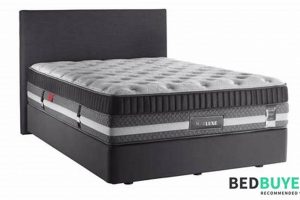A sleeping surface offering a balance between support and cushioning is often sought. This balance aims to provide spinal alignment while alleviating pressure points. Mattresses in this category generally feature a core of supportive materials, such as coils or foam, topped with a comfort layer designed to conform to the body’s contours. For example, a hybrid mattress with individually wrapped coils and a memory foam layer could fall into this firmness range.
This particular level of support and give is frequently recommended for a wide range of sleeping positions. Back sleepers benefit from the spinal support, while side sleepers appreciate the pressure relief on their shoulders and hips. Historically, mattresses of varying firmness were primarily available with innerspring construction. Modern materials and manufacturing techniques have expanded the options to include memory foam, latex, and hybrid designs, all engineered to achieve this balanced feel. The widespread appeal is derived from its potential to accommodate diverse needs and preferences.
The following discussion will delve into the specific types of materials used in constructing these sleep surfaces, examine the factors influencing perceived comfort, and provide guidance on selecting the most suitable option based on individual requirements and circumstances. Considerations of body weight, sleeping position, and potential health concerns will be addressed to facilitate informed decision-making.
Guidance for Optimal Selection
Selecting a sleep surface is a personal endeavor requiring careful consideration of various factors. The following tips offer guidance in navigating the options available, with the objective of identifying a model that best aligns with individual needs and preferences.
Tip 1: Assess Individual Sleep Position. The primary sleeping position significantly influences the optimal support level. Back sleepers generally require consistent support, while side sleepers benefit from increased cushioning at pressure points such as the shoulders and hips. Stomach sleepers often require a firmer surface to prevent excessive spinal curvature.
Tip 2: Consider Body Weight and Build. Body weight distribution impacts the perceived firmness. Individuals with higher body weight may find a medium firmness mattress feels softer than those with lower body weight. Trial testing, when feasible, is recommended to gauge the true feel of the mattress.
Tip 3: Evaluate Material Composition. Different materials offer varying degrees of support, pressure relief, and temperature regulation. Memory foam conforms closely to the body but can retain heat. Latex offers a more responsive feel with natural breathability. Hybrid models combine the benefits of multiple materials, such as coils and foam.
Tip 4: Examine Edge Support. Robust edge support is essential for those who sit on the edge of the bed or tend to sleep near the periphery. Insufficient edge support can lead to a feeling of roll-off and reduced usable sleep surface.
Tip 5: Prioritize Spinal Alignment. Proper spinal alignment is crucial for minimizing back pain and promoting restful sleep. A sleep surface that allows the spine to maintain its natural curvature is highly recommended. Consult with a healthcare professional if pre-existing spinal conditions are present.
Tip 6: Explore Trial Periods and Return Policies. Reputable manufacturers and retailers often offer trial periods, allowing consumers to test the mattress at home before committing to a purchase. Thoroughly review the return policy to understand the terms and conditions.
Tip 7: Consider Partner Preferences. If sharing a bed, consider the needs and preferences of both individuals. A mattress that minimizes motion transfer can be beneficial in preventing disturbances during sleep.
In summary, informed selection requires a comprehensive assessment of individual needs, preferences, and physical considerations. A balanced approach, incorporating research, testing, and a thorough understanding of available options, will increase the likelihood of identifying an appropriate sleeping surface.
The subsequent sections will explore specific mattress types and technologies relevant to achieving optimal sleep quality and comfort.
1. Spinal alignment support
Spinal alignment support constitutes a critical aspect of mattress design, directly impacting sleep quality and long-term musculoskeletal health. Its relationship to a sleep surface hinges on the capacity of the latter to maintain the natural curvature of the spine throughout the night, minimizing stress on vertebral discs and surrounding tissues.
- Contour Conformance and Load Distribution
The ability of a mattress to conform to the body’s contours is paramount for distributing weight evenly and preventing concentrated pressure points. A sleep surface with adequate conformance allows the spine to rest in a neutral position, mitigating strain on the lumbar region. For example, memory foam and latex materials are frequently employed to achieve this level of conformance, effectively cradling the body’s shape. The distribution of the load has the result of reduced muscle effort needed in the spine region during sleep.
- Firmness Level and Positional Accommodation
The overall firmness of the sleep surface must align with the individual’s sleeping position and body weight to ensure proper spinal support. A too-soft surface may lead to excessive sinkage, causing spinal misalignment, while a too-firm surface may create pressure points and restrict natural spinal curvature. Balancing firmness with positional support is key, and medium-firm options frequently provide a compromise suitable for diverse sleeping styles, promoting a neutral spinal posture for most individuals. The alignment support becomes easier to achieve.
- Core Support and Structural Integrity
The underlying support system of a sleep surface, whether composed of innersprings, foam cores, or hybrid configurations, plays a crucial role in maintaining spinal alignment. A robust core prevents sagging and ensures consistent support across the entire sleep surface. Degradation of this core over time can lead to misalignment and discomfort. Mattresses employing high-density foam or reinforced coil systems generally offer greater long-term spinal support. The body can be properly supported due to structural integrity.
- Impact on Musculoskeletal Health
Inadequate spinal alignment during sleep can contribute to a range of musculoskeletal issues, including back pain, neck stiffness, and sciatica. Prolonged misalignment can exacerbate pre-existing conditions and impede the body’s natural healing processes. Choosing a sleep surface that prioritizes spinal alignment support is therefore a proactive measure in maintaining musculoskeletal health and preventing chronic pain. Health problems during sleep are reduced by a support mechanism.
These considerations colle
ctively underscore the importance of spinal alignment support when evaluating mattresses. The features of a sleeping surface, from its contouring properties to its firmness and core support, directly influence its ability to promote healthy spinal posture and contribute to overall sleep quality. The proper support helps provide an optimal sleep experience.
2. Pressure point relief
Pressure point relief is a central characteristic of mattresses designed for enhanced sleep comfort and reduced musculoskeletal discomfort. The capacity to alleviate pressure on specific areas of the body, such as the shoulders, hips, and knees, is a key determinant of sleep quality and overall well-being. Mattresses within the medium firmness category are often engineered to strike a balance between support and cushioning, facilitating pressure relief without compromising spinal alignment.
- Material Conformity and Distribution of Body Weight
The composition of the mattress’s comfort layers significantly influences pressure point relief. Materials like memory foam and latex exhibit viscoelastic properties, conforming to the body’s contours and distributing weight over a broader surface area. This reduces localized pressure on bony prominences, promoting improved circulation and minimizing discomfort. For example, a memory foam top layer can contour to the sleepers body, reducing pressure on the hips for side sleepers.
- Firmness Level and Surface Compliance
The firmness of the mattress dictates the degree of surface compliance and, consequently, the extent of pressure relief. Mattresses with excessive firmness may create pressure points, while those that are too soft may lack adequate support. Medium firmness mattresses often offer a suitable compromise, providing sufficient cushioning to alleviate pressure on sensitive areas without allowing excessive sinkage that can compromise spinal alignment. This balanced firmness adapts to a range of body weights and sleeping positions.
- Zoned Support Systems and Targeted Pressure Relief
Some mattress designs incorporate zoned support systems, featuring varying levels of firmness in different areas to target specific pressure points. For instance, the shoulder and hip regions may be constructed with softer materials to provide enhanced cushioning, while the lumbar region receives firmer support to maintain spinal alignment. This targeted approach to pressure relief can be particularly beneficial for individuals with pre-existing musculoskeletal conditions. The zoned support addresses specific areas requiring more relief.
- Impact on Sleep Quality and Musculoskeletal Health
Effective pressure point relief contributes directly to improved sleep quality by minimizing discomfort and reducing the need for positional adjustments during the night. By alleviating pressure on sensitive areas, these sleeping surfaces can decrease tossing and turning, promote deeper and more restorative sleep, and reduce the risk of developing or exacerbating musculoskeletal pain. A sleeping surface that offers this benefit can lead to improvements in both physical and mental well-being.
These interlinked elements highlight the integral relationship between material composition, firmness level, zoned support, and their impact on pressure point relief in sleeping surfaces. When correctly engineered, a medium firmness mattress can deliver optimized pressure relief, thereby improving sleep quality and promoting long-term musculoskeletal health. The correct support helps provide a healthier and longer sleep.
3. Versatile sleep position
The accommodation of diverse sleeping postures is a significant factor in determining the suitability of a mattress. Individuals often transition between various positions throughout the night, necessitating a sleep surface capable of providing adequate support and comfort across a range of orientations.
- Adaptation to Back Sleeping
Back sleeping requires a mattress that supports the natural curvature of the spine, preventing excessive sinking or pressure on the lower back. A medium firmness mattress typically provides sufficient support to maintain spinal alignment in this position, distributing weight evenly and minimizing pressure points. For example, the balance between support and cushioning prevents the hips from sinking too deeply, which could strain the lower back muscles.
- Accommodation of Side Sleeping
Side sleeping demands sufficient cushioning to alleviate pressure on the shoulders and hips. A medium firmness mattress, often incorporating comfort layers of memory foam or latex, conforms to the body’s contours, reducing pressure on these sensitive areas. A surface that is too firm will cause pressure points, whereas a surface that is too soft will cause the spine to bow.
- Consideration for Stomach Sleeping
Stomach sleeping may require a firmer surface to prevent excessive spinal curvature. While a medium firmness mattress may not be ideal for exclusive stomach sleepers, it can often provide adequate support for individuals who occasionally adopt this position. However, individuals who predominantly sleep on their stomachs may benefit from a firmer mattress to maintain proper spinal alignment.
- Responsiveness to Positional Changes
The ability of a mattress to readily adapt to positional changes is crucial for ensuring uninterrupted sleep. A medium firmness mattress, particularly those incorporating responsive materials like latex or hybrid designs, allows for easier movement and prevents the feeling of being “stuck” in one position. This responsiveness minimizes sleep disturbances and promotes greater overall comfort. Materials easily adapting, like latex, contribute to the surfaces responsiveness.
The capacity to accommodate back, side, and occasional stomach sleeping positions, coupled with responsiveness to positional changes, contributes to the versatility. Its balanced support and cushioning make it a viable option for individuals who prioritize the ability to transition comfortably between various sleep postures. The ability to support multiple positions provides a good sleep.
4. Broad comfort preference
The appeal of a sleep surface stems from its ability to satisfy a diverse range of comfort expectations. A primary attribute contributing to its market presence is its capacity to accommodate a significant segment of the population. Mattresses in this category are designed to provide a balanced feel, avoiding the extremes of excessive firmness or yielding softness. This balanced approach is intended to cater to individuals who find overly firm mattresses uncomfortable due to pressure points, as well as those who dislike the sinking sensation associated with softer alternatives. The objective is a design that meets the needs of a large demographic.
Real-world data and consumer feedback consistently demonstrate the effectiveness of medium-firm mattresses in addressing varied comfort requirements. For instance, studies analyzing customer sat
isfaction ratings reveal that medium-firm models frequently receive higher scores from a broader cross-section of users compared to their firmer or softer counterparts. This indicates a wider acceptance of the feel and support characteristics offered by medium-firm mattresses. The balanced nature of the firmness appears to satisfy more customers. Retailers and sleep specialists often recommend these mattress options as a safe starting point for consumers unsure of their preferred firmness level, highlighting their suitability for diverse preferences. The suitability makes decision-making easier for consumers.
The correlation between broad comfort preference and the design of the sleep surface lies in its attempt to find a middle ground that addresses the most common complaints and expectations associated with sleep surfaces. This deliberate design choice maximizes its potential customer base. Understanding this connection is crucial for manufacturers aiming to produce versatile and widely appealing products, as well as for consumers seeking a comfortable sleep solution without prior knowledge of their specific needs. This alignment leads to a more streamlined purchasing process and increased customer satisfaction. The satisfaction of both producer and consumer is beneficial in this instance.
5. Balanced support feel
The “best medium firmness mattress” achieves its designation through a combination of characteristics, with a balanced support feel being paramount. This balance is not merely a subjective perception; it is the result of specific engineering choices regarding materials, construction, and design. The “best medium firmness mattress” provides sufficient give to conform to the sleeper’s body contours, thus relieving pressure points. Concurrently, it offers enough resistance to maintain spinal alignment, preventing the sleeper from sinking too deeply into the mattress. A lack of such equilibrium would result in either discomfort due to excessive pressure or spinal misalignment leading to aches and pains. As a practical example, consider a mattress composed of a high-density foam core overlaid with a layer of memory foam. The core offers support, while the memory foam provides contouring, creating a balanced feel.
The importance of this balanced support feel extends beyond immediate comfort. A mattress lacking sufficient support can contribute to long-term musculoskeletal issues, while one lacking adequate cushioning can disrupt sleep due to pressure point discomfort. Therefore, “best medium firmness mattresses” are frequently recommended by chiropractors and sleep specialists as a compromise for individuals unsure of their specific support needs. Moreover, this balance has practical significance for couples with differing sleep preferences. It often serves as an acceptable middle ground, accommodating both individuals’ comfort levels and minimizing sleep disturbances. Its design often features a high-density foam.
In summary, the “best medium firmness mattress” hinges on the concept of balanced support. This balance, achieved through specific design and material choices, is crucial for both immediate comfort and long-term musculoskeletal health. While individual preferences vary, the widespread appeal of these mattresses underscores the practical significance of this equilibrium in accommodating a broad range of sleep needs. There is widespread appeal to these mattresses because of the importance of a sleep surface.
Frequently Asked Questions About Best Medium Firmness Mattresses
The subsequent questions address prevalent inquiries concerning a specific category of sleep surfaces. This section provides concise, fact-based answers to aid in informed decision-making.
Question 1: What defines “medium firmness” in a mattress?
The term refers to a mattress that is neither excessively firm nor excessively soft. It generally falls on a scale of 1 to 10, with 1 being the softest and 10 being the firmest, between 5 and 7. This designation indicates a balance between support and cushioning.
Question 2: Are these mattresses suitable for all sleeping positions?
While individual preferences vary, medium firmness mattresses are often recommended for a wide range of sleeping positions. They typically provide adequate support for back sleepers and sufficient cushioning for side sleepers. Exclusive stomach sleepers may require a firmer surface.
Question 3: How does body weight influence the perceived firmness?
Individuals with higher body weights may perceive a medium firmness mattress as being softer than those with lower body weights. This is due to increased compression of the mattress layers. Trial testing is recommended when feasible.
Question 4: What materials are commonly used in constructing medium firmness mattresses?
Common materials include memory foam, latex, innersprings, and hybrid combinations of these. Each material offers varying degrees of support, pressure relief, and temperature regulation.
Question 5: How long do these mattresses typically last?
The lifespan depends on factors such as material quality, usage, and care. High-quality medium firmness mattresses can last for 7-10 years or longer. Regular rotation and the use of a mattress protector can extend the lifespan.
Question 6: Do these mattresses help with back pain?
Many individuals with back pain find relief from the balanced support and pressure relief offered by medium firmness mattresses. However, it is essential to consult with a healthcare professional for personalized recommendations based on individual conditions.
In summary, this style represents a versatile option for a diverse range of individuals and sleep preferences. Careful consideration of individual needs and preferences remains paramount when selecting a mattress.
The following sections will explore specific brands and models within the medium firmness category, providing comparative analyses and consumer reviews.
Conclusion
The exploration of “best medium firmness mattress” has underscored its position as a versatile and widely appealing sleep surface. Its inherent design, balancing support and cushioning, addresses a broad spectrum of sleep preferences and positional needs. This investigation has highlighted the critical roles of material composition, firmness calibration, and spinal alignment support in realizing optimal sleep quality and comfort. The balanced nature provides a suitable experience for most individuals
Selection of a sleeping surface remains a highly personal endeavor. While the information provided offers a comprehensive overview of “best medium firmness mattress” attributes, consumers are encouraged to conduct thorough research, consider individual requirements, and, when possible, engage in trial testing. The pursuit of a sleep solution tailored to unique needs represents a crucial investment in long-term health and well-being.


![Top-Rated: Choosing the Best Mattress Foundation [Guide] Organic & Natural Mattress Buyer’s Guide: Non-Toxic Sleep Solutions Top-Rated: Choosing the Best Mattress Foundation [Guide] | Organic & Natural Mattress Buyer’s Guide: Non-Toxic Sleep Solutions](https://mattressworldpa.com/wp-content/uploads/2025/07/th-7633-300x200.jpg)




![How to Find the Best Way Twin Air Mattress [Guide] Organic & Natural Mattress Buyer’s Guide: Non-Toxic Sleep Solutions How to Find the Best Way Twin Air Mattress [Guide] | Organic & Natural Mattress Buyer’s Guide: Non-Toxic Sleep Solutions](https://mattressworldpa.com/wp-content/uploads/2025/07/th-7628-300x200.jpg)